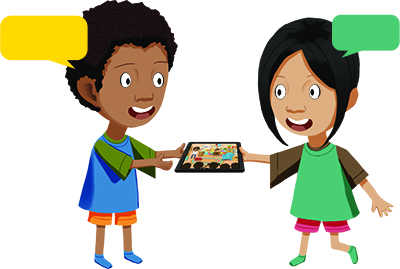What is a dialect?
- Working with children who speak Indigenous languages/dialects
- Partnering with family and community
- Working with children’s first language(s)
- Understanding the local context
- The impact of Australia’s history on Indigenous languages
- Resources
- Building on Indigenous children’s strengths
- Which Indigenous languages are spoken where?
- Mapping Indigenous languages
- Traditional languages
- New contact languages
- Englishes
- What is a dialect?
- How children learn Standard Australian English as an additional language or dialect
- A day in the life of …
- The difference between language and literacy learning
- The role of language in learning
- Bilingual schools
- Setting up for success

Do all English-speakers speak a dialect?
The term ‘dialect’ means mutually understood varieties of the one language. Nowadays we are all familiar with different dialects of English from film and television. If we look to our nearest English-speaking neighbour, New Zealand, we recognise there are some words that New Zealanders pronounce differently (fesh and cheps = fish and chips), some English words they use differently (dairy = local corner shop) and they also include Maori words that are unfamiliar to us (Aotearoa = New Zealand).
In spite of these differences, English-speaking Australians and New Zealanders can understand each other easily. We can use English with New Zealanders or any other English speakers to clarify any dialect differences we don’t understand. For these reasons, we would not consider New Zealand English speakers in need of English-language teaching to access classroom teaching nor of correction for their accent.
Everybody speaks a dialect (variety) of the language(s) they know; some people speak more than one dialect. In fact, we often code switch between dialects when we move between our work environment and home, family and friends. Dialects differ from each other mostly in terms of the accent (how some sounds are pronounced) and some words and their meanings (the vocabulary).
There are different dialects of English spoken in Australia, some are very close to the national standard variety, SAE, but some are more different. Some Indigenous people have particular ways of speaking English too. Sometimes, these varieties are collectively called ‘Aboriginal English’, but in actual fact these dialects are not all the same. Indigenous people can often tell where other Indigenous speakers of English come from by the way they talk.
For more about this topic, see the Tracks to Two-Way Learning resources, in particular the Focus Area ‘Understanding language and dialect’.
EAL/D learners
The term for English language learners in Australia has recently been changed to ‘English as an Additional Language or Dialect (EAL/D)’ in order to include speakers of any dialect that is so different from SAE that speakers benefit from English language teaching.
The varieties targeted by this new terminology are the heavier forms of Aboriginal English which do not allow speakers automatic access to SAE, and vice versa. As this section outlines, there is a range of varieties that can be called a ‘dialect’, so this needs to be thoughtfully applied, as not all dialect differences require teaching English as an L2. All dialects are equally valid ways of speaking and should be respected by educators as an expression of children’s identity and culture.
Dialects in traditional Indigenous languages and new contact languages
Traditional Indigenous languages and new contact languages also have dialects. For this reason, you might hear comments about somebody from a different community speaking (a bit) differently even though they speak the same language as the community. This might be recognisable in some of the words they use, or how words are pronounced. Books in Indigenous languages might also represent a different dialect to what is spoken locally. Usually this is not a problem for communication, but it might cause lively discussions about changing the wording or using a more local piece of content instead.